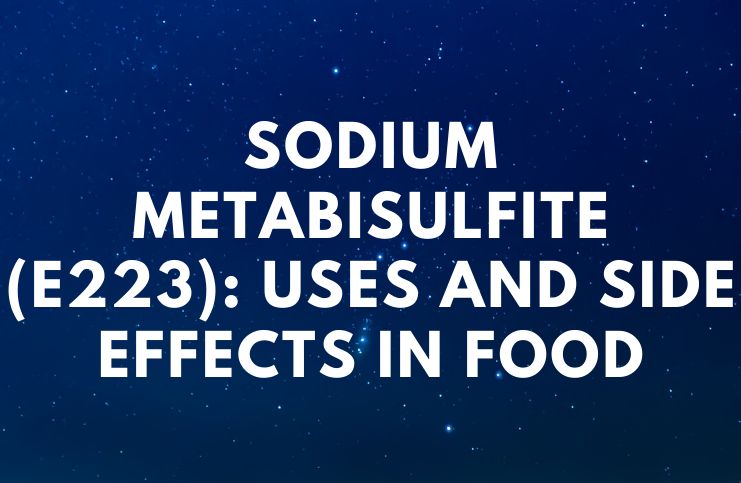Sodium Metabisulfite (E223): Uses and Side Effects:
Sodium metabisulfite (chemical formula Na2S2O5), also called disodium, is a white-yellowish crystalline powder used as an antioxidant, disinfectant, and preservative agent.
It easily dissolves in water.
This inorganic compound is produced by treating 50-70 percent sodium hydroxide (also known as caustic soda) with sulfur-dioxide-containing gasses in a saturated sodium hydrogen sulfite solution.
Therefore, this food preservative is considered vegan.
Uses
This compound is used for beer and winemaking to sanitize equipment (acts as an oxygen scavenger).
It is also used as a purification substance for potable water reverse osmosis membranes in different desalination systems.
Moreover, this compound is used in the gas and oil industry as a corrosion inhibitor/oxygen scavenger.
Furthermore, it is used in photography as an excipient in some tablets, such as paracetamol, and as an antioxidant additive in injectable medicines.
It functions as a bleaching agent that is quite useful in making cotton, paper pulp, and wool.
As a food preservative, it is known as E223 and has antimicrobial properties. It inhibits the growth of bacteria and fungi, thus, it helps the food to remain safe and fresh.
It is usually used for:
- dried foods, like raisins, dates, and apples;
- frozen foods (especially vegetables),
- fruit concentrate juices;
- pickles;
- alcoholic/non-alcoholic cider, beer, wine;
- vinegar, wine vinegar, apple cider vinegar;
- baked goods;
- gravies, dressings, sauces, guacamole, soup mixes, and soups;
- bottled lime and lemon juice/concentrate;
- tomato paste/pulp/purée;
- Canned/frozen vegetables and fruits;
- Cereal, cornstarch, cornmeal, muesli, and crackers;
- sugar syrups;
- pickled condiments, like – horseradish, sauerkraut, and coleslaw;
- condiments, such as – mustard, ketchup, and relish;
- soy products (tofu);
- deli meats, sausages, and hot dogs;
- starches;
- dried vegetables;
- snack foods;
- dried spices, herbs, tea;
- fish and shellfish;
- processed potatoes (like frozen French fries);
- fresh grapes;
- glazed/glacéed fruits;
- fruit syrups, fruit fillings, jams, gelatines, marmalade, jellies, pectin, molasses.
Additionally, this chemical is used as an ingredient in hair care products, like – hair bleaches, shampoos, tints and colors, hair dyes, coconut cream production, muscle soreness products, anti-aging products, and also in some skin and bath care products.
This compound is used to remove chloramine (an inorganic compound with the formula NH2Cl) from drinking water after treatment. 3.0 mg of E223 removes 1.0 mg of chlorine.
Dosage
The maximum daily intake is considered to be 0.7 milligrams per kilogram of body weight.
A fatal dose is about 10 g for the average adult.
Side Effects of Sodium Metabisulfite (E223)
Allergy
This compound may cause allergic reactions in people who are sensitive to sulfites (according to the FDA, about 1 in 100 individuals is sensitive), including respiratory adverse reactions in asthmatics and other allergic reactions in sensitive individuals.
Common symptoms and signs of allergic reactions include:
- coughing, chest tightness, and shortness of breath.
- dry, red, and cracked skin;
- feeling sick, tummy pain, diarrhea, or vomiting;
- swollen tongue, lips, eyes, or face;
- an itchy, runny or blocked nose;
- itchy, red, watering eyes;
- a raised, itchy, red rash (hives).
Note – the allergy attacks might range from mild to severe, depending on how much of the food additive got into your body and the way the body reacts to it.
In the case of contact, pure E223 can irritate the skin, which can lead to itching, redness, and pain. You should immediately flush the exposed area with plenty of cold water for 15 minutes.
More importantly, it is recommended to cover the irritated area with an emollient.
Cancer
Exposure to this chemical has been associated with reproductive and developmental toxicity and cancer.
Vision Problems
In addition, ingesting interferes with the absorption of vitamin B1 (better known as thiamine).
Vitamin B1 is an important mineral that helps the body in carbohydrate absorption and has an essential role in the prevention of neurodegeneration and severe eye fatigue.
Thiamine deficiency can lead to various chronic diseases and beriberi (symptoms include – mental confusion, shortness of breath during physical exercise, or involuntary eye movement).
Osteoporosis
Lastly, this substance increases the excretion of calcium, which is the most abundant mineral in the human body.
This mineral is best known for its crucial role in protecting from osteoporosis and bone health.
Calcium deficiency symptoms include – difficulty swallowing, muscle cramps, or chest pains. Another sign of deficiency of this mineral in the body is insomnia.
Insomnia symptoms may include:
- increased errors;
- difficulty falling asleep at night;
- difficulty paying attention;
- waking up during the night;
- anxiety;
- waking up too early;
- depression;
- daytime tiredness;
- not feeling well-rested after a night’s sleep.
READ THIS NEXT:
Sodium Stearoyl Lactylate (E481) – Uses
Sodium Citrate | Citric Acid (E331) – Uses
References https://www.ncbi.nlm.nih.gov/pubmed/14555420 http://www.parchem.com/chemical-supplier-distributor/




Can this compound dissolve actual bone tissue/ matter ?
No wonder people are suffering not knowing the side affects of E223. Why the hell put this in organic or grass fed meats as this will mean it is No longer Organic. We pay a huge price to get organic grass fed with the understanding it is not tampered with. I will be watching more closely to what I purchase from here on.